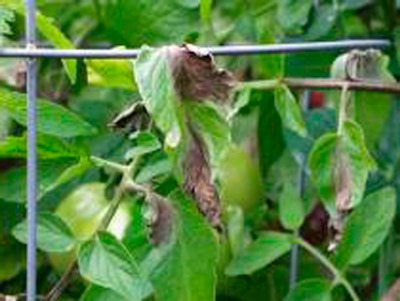Oh tomatoes! So many gardeners anticipate them. First, the plant “takes hold” and the leaves turn a luxurious dark green; then the yellow blossoms appear. Soon the fruit begins to show, and in a few more weeks you are picking the first tomato of the season.
That is unless your plants become victim to one of the most destructive tomato diseases — LATE BLIGHT!
Late blight is common west of the Cascades. It is caused by a fungus-like microorganism, Phytophthora infestans, which thrives in moist conditions and infects not only tomatoes, but potatoes and other members of the Solanaceae (nightshade) family.
Although labeled late blight, this disease can occur any time of the season and in a broad temperature range. Rainy weather, dew and fog are favorable conditions for late blight. Add to that excess foliage, poor air circulation and overhead watering and you have created the perfect environment for late blight.
Late blight can be recognized by irregular, greenish, water-soaked spots appearing on tomato leaves or stems. Under cool, moist conditions, these quickly change to purple-black lesions.
Leaves and stems develop black or brown streaks. Leaves die and drop. On green fruit, water-soaked, gray-green spots form, enlarge and become leathery-brown.
Once present, late blight is very difficult to control. Immediately remove infected leaves, plants and fruit, including those that have fallen from the plant.
Infected material must be destroyed to prevent the fungal spores from spreading. Do not compost it.
Bag the infected material and discard as trash or burn it. (Check local regulations before burning.)
Prevention is the best approach. Consider planting tomato varieties that are blight tolerant and appropriate to the growing season of the North Olympic Peninsula.
Avoid conditions conducive to late blight. Avoid excess foliage by using a low-nitrogen fertilizer (5-10-10) and pruning plants; water at the base of the plant and ensure ample air circulation by proper spacing of tomatoes.
Fungicide applications can be made to protect leaves, vines and fruit from infection. Monitor weather forecasts for damp, foggy or humid conditions and apply a preventative-type fungicide.
Fungicides will not eradicate the fungus from infected tissue but will help to protect uninfected tissue.
Carefully read the fungicide label before purchasing. Make sure the plant name and “Late Blight” are shown on the label and follow the directions for application.
After applying the fungicide, closely monitor the plant for signs of infection and follow directions regarding additional applications. If the disease appears and spreads to a significant portion of the plant, the fungicide may be of little use.
At the end of the season, discard all infected tomato fruit and potato tubers. If infected tomatoes or potatoes were left in or on the ground and did not freeze, they can spread infection to tomatoes and potatoes planted next season.
As exciting as it is to see volunteer plants popping up in the spring, pull and discard them. Volunteer plants carrying the fungus can infect other plants.
A homegrown tomato is worth the effort! Oh tomatoes!
Pearl of Wisdom
Late blight is one of the most contagious and destructive of plant diseases. The earlier a diseased plant is spotted and removed, the less likely it is to spread to other tomato plants in your garden.
Routinely scrutinize your garden for symptoms of late blight and take quick action if suspicious lesions are found.
For more
For more gardening information, attend a Saturday in the Garden presentation at the Master Gardener Demonstration Garden at 2711 Woodcock Road in Sequim. These free educational events are held on selected Saturdays. On July 23 from 10-11 a.m., Clallam County Master Gardener Judy Mann will talk about vermicomposting (composting with worms).
Judy English is a certified WSU Clallam County Master Gardener.



